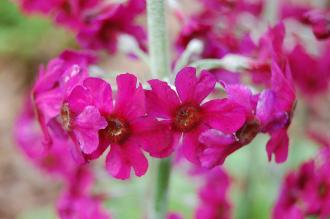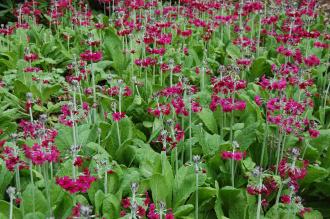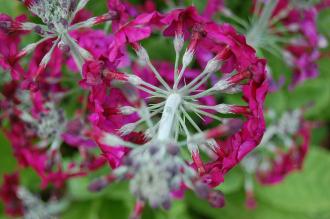
Primula pulverulenta Flower (05/05/2012, Kew Gardens, London)
Position: Full sun to partial shade
Flowering period: Late spring to early summer
Soil: Moist, humus rich
Eventual Height: 80cm
Eventual Spread: 30cm
Hardiness: 5a – 9a
Family: Primulaceae
Primula pulverulenta is a spring flowering semi-evergreen, low growing herbaceous perennial. Its mid green leaves are elliptic with irregularly dentate margins, tapering at the base, up to 18cm long, 8cm broad and arranged in a rosettes. Its stems and flower buds are covered in white/ gray powder. Its bright pink flowers are bell shaped, up to 2.5cm across, appear in whorls around an erect stem, each plant producing up to six whorls.

Primula pulverulenta (05/05/2012, Kew Gardens, London)
Primula pulverulenta, commonly known as the Candelabra Primula, is native to west Sichuan, China. In its native habitat it grows in damp/ wet meadows.
The etymological root of the binomial name Primula is from the Latin name for the Primrose. Pulverulenta is derived from the Latin pulvis meaning ‘dust’, in reference to the powdery covering on this pant.
The landscape architect may find Primula pulverulenta useful as a marginal plant at the edge of ponds, lakes and rivers.
Ecologically, P. pulverulenta is attractive to pollinating insects.

Primula pulverulenta Detail (05/05/2012, Kew Gardens, London)
The Royal Horticultural Society has given P. pulverulenta their prestigious Award of Garden Merit in 1993.
P. pulverulenta prefers moist, humus rich, poorly drained soils. It prefers an acid to neutral pH of soil, although it will tolerate most pH of soil. It will not tolerate dry soils.
Primula pulverulenta requires little maintenance.

